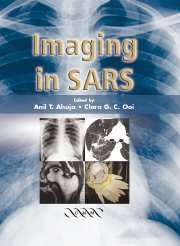Book contents
- Frontmatter
- Contents
- Contributors
- Preface
- 1 The Epidemiology of Severe Acute Respiratory Syndrome: A Global Perspective
- 2 The Role of Emergency Medicine in Screening SARS Patients
- 3 Severe Acute Respiratory Syndrome Outbreak in a University Hospital in Hong Kong
- 4 Imaging of Pneumonias
- 5 The Role of Chest Radiographs in the Diagnosis of SARS
- 6 Chest Radiography: Clinical Correlation and Its Role in the Management of Severe Acute Respiratory Syndrome
- 7 The Role of High-Resolution Computed Tomography in Diagnosis of SARS
- 8 The Role of Imaging in the Follow-up of SARS
- 9 Treatment of Severe Acute Respiratory Syndrome
- 10 SARS in the Intensive Care Unit
- 11 Imaging of Pneumonia in Children
- 12 Imaging and Clinical Management of Paediatric SARS
- 13 Imaging of SARS in North America
- 14 Radiographers' Perspective in the Outbreak of SARS
- 15 Implementation of Measures to Prevent the Spread of SARS in a Radiology Department
- 16 Aftermath of SARS
- 17 Update on Severe Acute Respiratory Syndrome
- Index
10 - SARS in the Intensive Care Unit
Published online by Cambridge University Press: 27 October 2009
- Frontmatter
- Contents
- Contributors
- Preface
- 1 The Epidemiology of Severe Acute Respiratory Syndrome: A Global Perspective
- 2 The Role of Emergency Medicine in Screening SARS Patients
- 3 Severe Acute Respiratory Syndrome Outbreak in a University Hospital in Hong Kong
- 4 Imaging of Pneumonias
- 5 The Role of Chest Radiographs in the Diagnosis of SARS
- 6 Chest Radiography: Clinical Correlation and Its Role in the Management of Severe Acute Respiratory Syndrome
- 7 The Role of High-Resolution Computed Tomography in Diagnosis of SARS
- 8 The Role of Imaging in the Follow-up of SARS
- 9 Treatment of Severe Acute Respiratory Syndrome
- 10 SARS in the Intensive Care Unit
- 11 Imaging of Pneumonia in Children
- 12 Imaging and Clinical Management of Paediatric SARS
- 13 Imaging of SARS in North America
- 14 Radiographers' Perspective in the Outbreak of SARS
- 15 Implementation of Measures to Prevent the Spread of SARS in a Radiology Department
- 16 Aftermath of SARS
- 17 Update on Severe Acute Respiratory Syndrome
- Index
Summary
Introduction
Severe acute respiratory syndrome (SARS) is clinically severe with a high proportion of cases, approximately 20%, requiring intensive care unit (ICU) admission. The provision of organ support in the ICU therefore plays a potentially important role in reducing mortality, which may be as high as 10% for younger patients and 50% for patients older than 60 years. Radiological imaging of the chest is important because of the overriding importance of respiratory failure in determining the management and outcome of SARS.
At the time of writing there were little published data detailing the ICU management and outcome of SARS, and much the information that follow are based on the observational data derived from our institution.
ICU admission
Patients generally present to the hospital with fever, chills, rigors, myalgia, headache and a non-productive cough. Common laboratory features include an elevated serum lactate dehydrogenase (LDH) concentration, lymphopaenia, hypocalcaemia and moderate thrombocytopaenia. SARS is a slowly progressive disease and the average interval from the onset of symptoms to requirement for ICU admission is approximately 10 days. Clinical deterioration of cases admitted to the ward is manifested by progressive hypoxia and dyspnoea, and is accompanied by progression of pulmonary infiltrates on chest radiograph. Close monitoring of disease progress in the general wards is therefore important to detect deterioration in those patients who will be admitted to ICU.
- Type
- Chapter
- Information
- Imaging in SARS , pp. 99 - 108Publisher: Cambridge University PressPrint publication year: 2004

